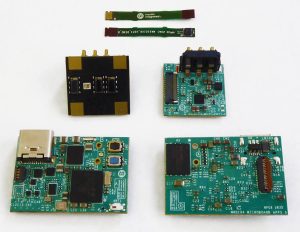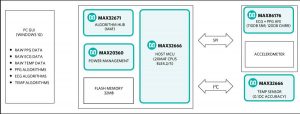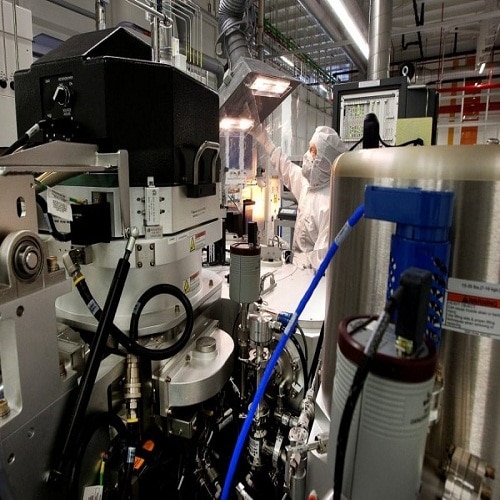Maxim is measuring blood oxygen, ECG, heart rate, body temperature and activity data in its third generation of wearable health monitor reference design, this time entirely wrist-worn.
Called Health Sensor Platform 3.0 (aka MAXREFDES104#), it comes in a ready-to-wear wrist form with algorithms to provide heart rate, heart-rate variability (HRV), respiration rate (RR), SpO2 , body temperature, sleep quality and stress level information “at clinical-grade levels” according to the company. “HSP 3.0 can be adapted for other dry electrode form factors such as chest patches and smart rings.”
Earlier HSP 2.0 lacked the optical SpO2 measurement and dry-electrode capability for ECG.
By adding these, HSP 3.0 “can enable end solutions to monitor cardiac heart and respiratory issues for management of ailments like chronic obstructive pulmonary disease, infectious diseases, sleep apnea and atrial fibrillation,” said Maxim.
Optical blood oxygen measurement depends on differential absorption of two different wavelengths of light, and depends on the depth of blood vessels at the measurement site. Clinical measurements are frequently made at the finger tip. A few years ago Belgian research lab IMEC highlighted the difficulties of getting fingertip-grade measurements at the wrist.
Has Maxim achieved a recognisable ‘clinical grade’ SpO2 measurement from the wrist?
“Finger tip based hospital SpO2 is typically much more accurate than the regulatory standard, for example the FDA, expects,” Maxim MD Andrew Baker told Electronics Weekly. “Perfusion index is the metric used to specify how good the device is at measuring low blood flow individuals where the signal is very weak – in older individuals for example. We can meet the FDA and CE regulatory accuracy standards for SpO2 measurement. We need to point out that we have not been through the regulatory approvals but have tested to the standard.”
Ambulatory ECG measurements meet IEC 60601-2-47, according to the company.
“During these times of the pandemic, there’s a drive towards point-of-use to monitor clinical-grade measurements such as SpO2, respiration and temperature,” said Baker. “Developers strive to continue this momentum of remote patient monitoring by creating solutions to provide deeper insight into health conditions, open doors to improve wellness and minimise the amount of time people need to visit healthcare facilities.”
- MAX86176 optical photoplethysmography (PPG) and electrical ECG analogue front end with 110dB signal-to-noise ratio for SpO2 saturation and >110dB common mode rejection ratio for dry electrode ECG. Acquisition of PPG and ECG can be synchronous, even with independent sample rates, providing pulse transit time for cardiac health use
- MAX20360 battery and power maanger including energy gauging, a haptic driver and low-noise buck-boost converter for optical bio-sensing
- MAX32666 Bluetooth LE enabled MCU with two Arm Cortex-M4F cores and an additional block “which permits running the BLE stack independently, leaving the two main cores available for major tasks”, said Maxim. Security and error correction are included.
- MAX32670 MCU dedicated to proprietary PPG algorithms for pulse rate, SpO2, HRV, RR, sleep quality and stress. Configured as a sensor hub to support firmware and algorithms, or as an algorithm hub to support multiple algorithms. Manages analogue front-ends and delivers raw or calculated data to outside world
- MAX30208: 2 x 2mm digital temperature sensor, reading through the top of the package. 0.1°C accurate
As wel as wrist-worn monitors, use is foreseen in chest, abdomen and forehead wearables – adhesive patches for example, as well as remote patient monitors.
The reference design web page is here
As well as the complete assembled wearable the reference design box includes:
- BLE USB Dongle (CY5677)
- USB-A to USB-C cable
- USB-A to Micro-USB cable
- Programmer Board (MAXDAP-USB-C)
 Other platform components (photo right) are:
Other platform components (photo right) are:
- Micro board including MAX32666 host MCU, MAX32670 algorithm hub, MAX20360 power manager, dual-mode Bluetooth and flash
- Sensor board including MAX86176 ECG and PPG front-end, optical heart-rate sensor with three LEDs (Green, Red and IR), three photodiodes, ECG electrodes and 3-axis accelerometer
- Sensor board 2 with MAX30208 body temperature sensor on flex cable
Source: electronicsweekly











